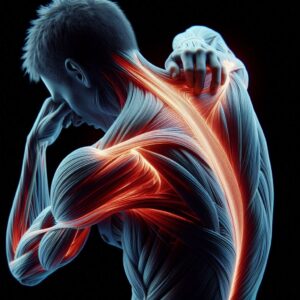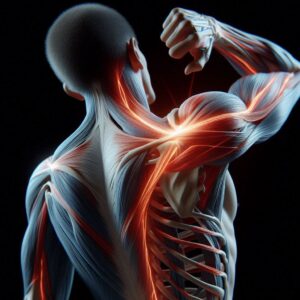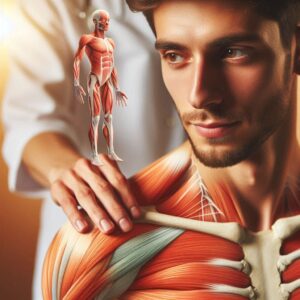Fascial Distortion Model: A Proven Approach to Treatment
The Fascial Distortion Model (FDM) is a diagnostic and treatment approach that emphasises identifying and rectifying distortions in the body’s connective tissue, called fascia. Fascia is a complex network of collagen and elastin fibres that supports muscles, organs, and structures throughout the body. Fascia distortion can lead to various symptoms, including pain, limited movement, and dysfunction in the affected area.
The FDM was created by American osteopathic physician Stephen Typaldos, D.O., in the 1990s. Dr. Typaldos noted that conventional medical approaches did not adequately address many musculoskeletal injuries and conditions, prompting him to develop a groundbreaking model for understanding and tackling these issues. The FDM categorises fascial distortions into six distinct types, each displaying unique symptoms and patterns of dysfunction.
The categories encompass Triggerband, Continuum Distortion, Cylinder Distortion, Herniated Triggerpoint, Folding Distortion, and Tectonic Fixation. The FDM distinguishes itself by focusing on the identification and treatment of specific fascial distortions through hands-on techniques rather than relying solely on imaging or other diagnostic approaches. Skilled practitioners in the FDM utilise palpation and observation techniques to identify areas of distortion within the fascia, subsequently applying focused manual therapies to address these issues effectively.
The FDM targets the underlying fascial distortions to alleviate pain, enhance function, and restore mobility in the affected body areas.
Summary
- The Fascial Distortion Model (FDM) serves as a comprehensive diagnostic and treatment framework focused on identifying and managing specific types of fascial distortions within the body.
- Fascial distortions can be identified through a comprehensive physical examination and a detailed patient history assessment—these issues frequently present as discomfort, restricted mobility, or additional symptoms.
- Treatment methods for fascial distortions can include manual therapy techniques such as manipulation, myofascial release, and exercise and movement therapies.
- The Fascial Distortion Model presents numerous benefits, including improved pain relief, increased range of motion, and faster injury recovery.
- Case studies and success stories demonstrate the effectiveness of FDM in tackling various musculoskeletal conditions and injuries.
- Integrating the Fascial Distortion Model with supplementary treatment approaches, such as physiotherapy and chiropractic care, provides a comprehensive strategy for managing patient care.
- Finding a qualified expert for Fascial Distortion Model treatment is crucial, necessitating a search for healthcare professionals with specialised training and FDM experience.
 Identifying Fascial Distortions in the Body
Identifying Fascial Distortions in the Body
Assessment Techniques
Experts skilled in FDM employ palpation and observation methods to identify specific types of fascial distortions guided by unique symptoms and patterns of dysfunction. For example, a Trigger and distortion can present as a taut, rope-like band of tissue that causes sharp, shooting pain with movement. Conversely, cylinder distortion can manifest as a swollen, sausage-shaped area of tissue that restricts movement and leads to aching or throbbing discomfort.
Assessment of Mobility and Diagnostic Imaging
In addition to palpation and observation, practitioners may employ movement assessments to identify areas of fascial distortion. By meticulously observing patients’ movements and how they perform tasks, practitioners can pinpoint areas of restricted mobility or dysfunctional movement patterns that may indicate underlying fascial distortions. Imaging studies, such as MRI or ultrasound, may be employed to confirm the presence of fascial distortions in specific cases; however, these methods are not always necessary for diagnosis.
Attention and Rehabilitation
Upon recognising fascial distortions, practitioners can develop a customised treatment plan that specifically targets these issues through focused manual therapies. These therapies may include techniques such as trigger and release, cylinder distortion reduction, or tectonic fixation reduction, all designed to precisely address each type of fascial distortion. By addressing these distortions, practitioners aim to relieve pain, improve function, and restore mobility in the affected area.
Treatment Techniques for Fascial Distortions
The treatment techniques utilised in the Fascial Distortion Model are based on precise manual therapies designed to address each type of fascial distortion specifically. These techniques encompass practical methods such as soft tissue manipulation, stretching, and mobilisation to relieve tension, reduce swelling, and restore normal function in the affected area. For example, Triggerband release techniques may involve applying pressure and stretching to the specific area to relieve tight tissue bands and reduce discomfort. Conversely, strategies for lowering cylinder distortion may employ gentle compression and mobilisation to alleviate swelling and improve mobility.
In addition to these specialised techniques, experts trained in FDM may integrate supplementary therapies such as ice or heat application, electrical stimulation, or therapeutic exercise to amplify the advantages of manual treatment and promote healing in the affected area. These complementary therapies are employed with manual techniques to address pain, inflammation, and dysfunction associated with fascial distortions. Treatment techniques in the FDM are tailored to each patient, considering their type of fascial distortion, individual symptoms, and patterns of dysfunction.
This customised approach allows professionals to effectively address the underlying pain and dysfunction issues, leading to enhanced patient results.
 Benefits of the Fascial Distortion Model
Benefits of the Fascial Distortion Model
The Fascial Distortion Model offers various benefits for those seeking relief from musculoskeletal pain and dysfunction. The FDM provides a notable benefit by focusing on the identification and treatment of specific fascial distortions that conventional medical approaches may overlook or misdiagnose. By tackling these core issues, the FDM aims to provide more effective relief from pain and dysfunction than traditional treatments, which frequently concentrate only on symptoms rather than addressing the root cause.
The FDM offers a significant benefit by emphasising practical manual therapies, which can provide immediate pain relief and improve functionality in the affected area. Many patients experience significant pain relief and improved mobility after just one or two sessions with a practitioner experienced in the FDM approach. This prompt response to treatment can be especially beneficial for those who have experienced chronic pain or limited mobility for an extended period.
FDM offers a customised treatment strategy that considers each patient’s unique symptoms and dysfunction patterns. By tailoring treatment approaches to address specific types of fascial distortions in each individual, practitioners proficient in FDM can provide more targeted and effective care that addresses the underlying causes of pain and dysfunction.
Case Studies and Success Stories
Many case studies and success stories illustrate the efficacy of the Fascial Distortion Model in relieving musculoskeletal pain and dysfunction. A case study published in the Journal of Bodywork and Movement Therapies presented a patient experiencing chronic low back pain who achieved significant relief after just two sessions of FDM treatment. The patient had pursued various conventional therapies without attaining the expected outcomes. Following FDM treatment targeting specific fascial distortions in the lower back, they reported a notable reduction in pain and improved mobility.
A case study published in the International Journal of Osteopathic Medicine examined a patient experiencing shoulder pain and restricted range of motion. A notable enhancement was observed after FDM treatment, which focused on correcting a cylinder distortion in the shoulder girdle. The patient reported significant pain relief and improved functionality after just one session of FDM treatment, underscoring the rapid effectiveness of the targeted manual therapies utilised in FDM. This compilation of case studies and success stories highlights the potential for fast relief from musculoskeletal pain and dysfunction through targeted manual therapies based on the Fascial Distortion Model.
People dealing with chronic pain or limited mobility can find significant relief and improved function after receiving FDM treatment from a qualified professional.
Integrating the Fascial Distortion Model with Other Treatment Modalities
Collaborative Assistance
Experts trained in the FDM often collaborate with other healthcare professionals, such as physiotherapists, chiropractors, and osteopaths, to develop a customised treatment plan that thoroughly addresses a patient’s condition.
Enhanced Treatment Outcomes
Combining the FDM with other evidence-based therapies, such as therapeutic exercise, chiropractic adjustments, or acupuncture, enables patients to achieve enhanced treatment outcomes and ongoing healing and recovery. This detailed approach can improve outcomes by addressing the complex needs of musculoskeletal pain and dysfunction individuals.
Tailored Treatment Solutions
Integrating FDM with supplementary modalities provides patients with an expanded range of treatment options, enabling tailored solutions to address their needs and conditions. Individuals facing intricate musculoskeletal challenges may benefit from integrating FDM treatment with physiotherapy to address strength and mobility deficits or combining it with acupuncture to reduce pain and inflammation.
 Finding a Qualified Practitioner for Fascial Distortion Model Treatment
Finding a Qualified Practitioner for Fascial Distortion Model Treatment
Individuals looking for alleviation from musculoskeletal pain and dysfunction should seek out a qualified practitioner in the Fascial Distortion Model treatment. Individuals with advanced training in FDM have the knowledge and skills to identify specific fascial distortions and apply targeted manual therapies to address these issues efficiently. When seeking a qualified practitioner for FDM treatment, patients should look for healthcare providers who have completed advanced training in FDM from reputable organisations, such as the American Fascial Distortion Model Association (AFDMA) or other recognised training institutions.
These courses provide practitioners with a comprehensive understanding of FDM principles, effective assessment techniques, and customised treatment protocols designed for each type of fascial distortion. Patients can receive referrals from their primary care physician or other healthcare professionals to locate qualified practitioners offering FDM treatment in their area. Additionally, online directories or industry associations may provide listings of practitioners who have completed advanced training in the FDM and are qualified to offer this specialised form of care.
Choosing a qualified expert for FDM treatment enables patients to receive customised manual therapies designed to address their specific fascial distortions, promoting rapid alleviation of musculoskeletal pain and dysfunction. This tailored care method can lead to more effective results for those seeking relief from chronic pain or limited mobility.
FAQs
What does the fascial distortion model (FDM) treatment entail?
The fascial distortion model (FDM) is a manual therapy approach designed to identify and relieve musculoskeletal pain and dysfunction by addressing distortions in the body’s connective tissue, called fascia.
What is the mechanism behind FDM treatment?
FDM treatment employs precise manual techniques to successfully release and realign distorted fascial tissues, relieve pain, improve mobility, and restore
Which conditions can FDM treatment assist with?
FDM treatment is commonly employed to address a range of musculoskeletal concerns, including back pain, neck pain, joint pain, sports injuries, and repetitive strain injuries.
Is FDM treatment appropriate for all individuals?
FDM treatment may not be suitable for everyone. It is essential to consult with a qualified healthcare expert to evaluate its appropriateness for your specific condition and medical history.
What potential side effects might arise from FDM treatment?
FDM treatment is generally considered safe; however, some individuals may experience temporary soreness or discomfort following a session. It is crucial to address any concerns with a qualified practitioner before undergoing FDM treatment.
What is the usual number of FDM treatment sessions required?
The number of FDM treatment sessions needed can vary depending on the individual and the details of their condition. Some individuals may observe significant improvement after just a few sessions, while others may require ongoing treatment to achieve their desired outcomes.
Brought To You By:
The Article: Fascial Distortion Model: Effective FDM Treatment appeared first on https://mcrtherapies.co.uk
The Article Fascial Distortion Model: Effective FDM Treatment appeared first on https://mcrtherapies.com
The Article Fascial Distortion Model: Effective FDM Treatment Was Found On https://limitsofstrategy.com



The Fascial Distortion Model certainly presents a fascinating perspective on musculoskeletal health. The emphasis on fascia as a crucial yet often overlooked component of our body’s interconnected systems is particularly compelling. In my experience as a practitioner, I’ve observed how addressing fascial restrictions can lead to significant improvements in patient outcomes, especially in cases where conventional treatment methods have failed.
It’s interesting to see how the Fascial Distortion Model has gained traction in recent years. Your observation about fascia being an often overlooked component of musculoskeletal health really resonates. In my own experience, I’ve found that many patients come in with symptoms that don’t seem to fit a traditional diagnosis, and when we begin to explore their fascial connections, it often uncovers underlying issues that had previously gone unaddressed.
It’s intriguing to hear about your experiences with the Fascial Distortion Model and the positive outcomes you’ve observed in your practice. Fascia can sometimes feel like that quiet, behind-the-scenes player in our bodies, but it’s clear you’ve seen firsthand how pivotal it can be to overall musculoskeletal health.
It’s really interesting to hear your perspective as a practitioner on the Fascial Distortion Model. The way you describe the oft-overlooked role of fascia resonates with a lot of what I’ve been reading about recently. It seems that, in our modern approach to healthcare, we’re starting to realize how interconnected our bodily systems are, and fascia definitely plays a pivotal role in that.
I appreciate hearing your thoughts on the Fascial Distortion Model. It really is fascinating how our understanding of bodily systems is evolving. The role of fascia, often overlooked, is crucial for maintaining not just physical health but overall well-being.
It’s interesting how the Fascial Distortion Model highlights the often-ignored connections in our bodies. You’re right; fascia is so much more than just a supportive structure. It acts almost like a communication network, affecting how our muscles, organs, and even emotions interact.
It’s interesting to hear your perspective as a practitioner who values the Fascial Distortion Model. The way you highlight fascia as an often overlooked component in musculoskeletal health resonates with my own experiences. So many times I’ve encountered patients who’ve tried various treatments without considering the fascial connections; it seems to open a new avenue for understanding their issues.
It’s encouraging to see how the Fascial Distortion Model resonates with your experiences in practice. The notion that fascia often takes a backseat in discussions around musculoskeletal health is something I’ve observed frequently. Many clinicians, whether they are physical therapists, chiropractors, or massage therapists, often lean towards the more visible structures, like muscles and joints, while the intricate web of fascia remains underrepresented.
It’s interesting how the Fascial Distortion Model has shifted the conversation for some of us in the field. I definitely agree that fascia often seems to be overlooked in favor of more prominent structures like muscles or joints. It’s like this hidden layer that influences so much of our movement and health, yet it often doesn’t get the attention it deserves.
It’s interesting to see how much attention fascia is starting to receive as our understanding of the body evolves. I’ve had similar experiences in practice, where it feels like the conversations often get dominated by muscles and joints, but fascia has such a critical role in overall musculoskeletal health. It’s like an invisible support system that influences so much of our movement and well-being.
You hit the nail on the head when you talk about fascia being that secret sauce we often overlook. It’s like the unsung hero in a blockbuster movie; everyone’s focused on the flashy leads, while the real MVP is back there coordinating all the behind-the-scenes action. It’s just wild how many folks throw everything at their musculoskeletal woes—treatment after treatment—while bypassing this connective tissue that’s literally tying everything together.
You know, you hit the nail on the head with the whole fascia situation. It’s like that background character in a movie who seems unimportant until you realize they’re woven into every subplot. Suddenly, you’re watching the whole thing unfold and thinking, “Hey, where’d this twist come from?” That’s fascia for you.
The Fascial Distortion Model (FDM) is indeed a fascinating perspective on musculoskeletal treatment, and it resonates deeply with my own experiences and observations within the realm of physical health and therapy. The intricate role fascia plays in our physical well-being is often overlooked, yet it is central to understanding how our body functions and responds to various stresses and strains.
I completely agree with you about the importance of the Fascial Distortion Model (FDM) in understanding musculoskeletal treatment. It’s interesting to think about how the fascia seems to weave together not just our muscles and bones, but also our experiences of pain and movement. I’ve found that when patients have an awareness of their fascia and its role, it often shifts their perspective on healing and bodywork.
It’s interesting how often the fascia is overshadowed in discussions about musculoskeletal health, isn’t it? Your observation reflects a growing recognition within the therapeutic community of its significant role. Personally, I’ve been exploring how fascia not only affects physical movement but also plays into our emotional and psychological health. The interconnectedness is quite profound.
Exploring the Fascial Distortion Model opens up fascinating possibilities for how we understand and treat our bodies. In my own experience with chronic pain, I often found traditional methods frustratingly insufficient. It wasn’t until I leaned into holistic approaches, like bodywork that considers the fascial system, that I began to see real change.
This is such an intriguing dive into the Fascial Distortion Model! I must admit, when I first heard about fascia, I thought it was just the stuff that held my donuts together at the bakery. Who knew it had such an important role in our bodies? It’s a bit like the unsung hero of the human anatomy—almost like the stage crew of a play, working hard behind the scenes while everyone else gets the spotlight.
It’s fascinating, right? The connection you’ve drawn between fascia and the behind-the-scenes crew of a play really resonates. Many people overlook fascia, much like how we might take the crew for granted until something goes wrong on stage. This connective tissue truly is a pivotal part of our bodies, holding everything together while also allowing for movement and flexibility.
It’s definitely fascinating how something as seemingly simple as fascia can have such profound effects on our health. I think your analogy of fascia being the “stage crew” is spot on; it’s always there, supporting everything that takes the spotlight yet often overlooked.
I appreciate how you’ve laid out the Fascial Distortion Model and its significance in understanding musculoskeletal pain and dysfunction. It’s really interesting to see how much our knowledge of anatomy and treatment approaches has evolved over the years, particularly with the incorporation of theories like FDM. I’ve often thought about how, as a society, we tend to overlook the intricacies of our body’s connective tissues. There’s so much happening beneath the surface that we might not even be aware of, and it feels like FDM is a step towards bridging that gap in our understanding.
It’s refreshing to see someone recognize the nuances of the Fascial Distortion Model and its potential impact on how we approach musculoskeletal issues. The evolution of our understanding of anatomy is indeed fascinating. It’s interesting how concepts like FDM offer a more holistic perspective on injuries and pain, emphasizing that it’s not just about the bones or muscles, but also how our connective tissues play a significant role in our overall health.
You’ve touched on an important point about the evolution of our understanding of the body and how we approach treatment. It’s fascinating to see how discussions around musculoskeletal pain are expanding to include the fascial system. For so long, traditional models of anatomy focused primarily on bones and muscles, almost ignoring the connective tissues that tie everything together. It’s like we’ve been looking at a landscape through a narrow lens, failing to appreciate the intricate connections that exist.
The Fascial Distortion Model is such a fascinating approach! I love how it shifts the focus to the connective tissue and its significant role in our overall health. It makes me think about how often we overlook the importance of fascia in our daily self-care and wellness routines.